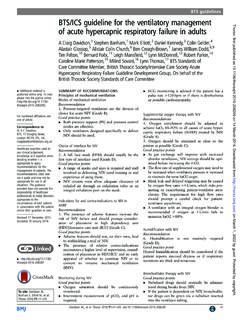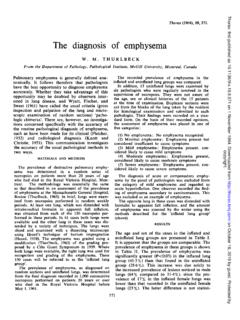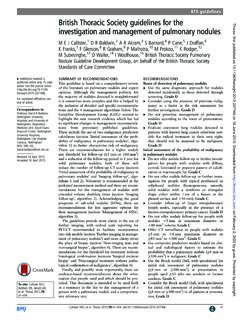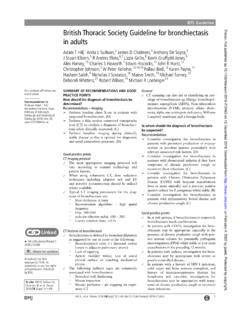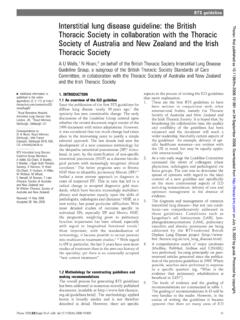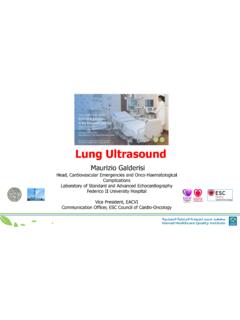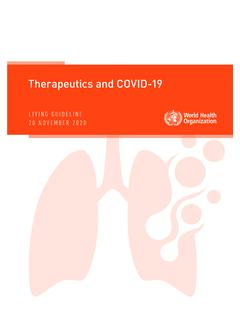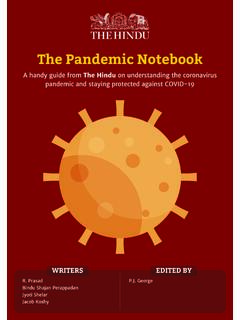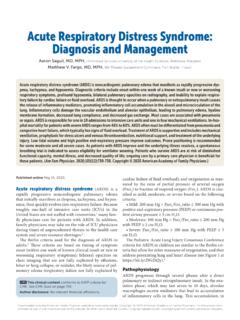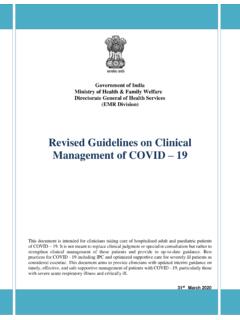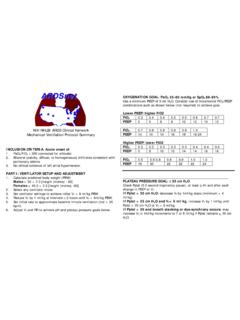Transcription of BTS GUIDELINE Non-invasive ventilation in acute ... - Thorax
1 192. BTS GUIDELINE . Thorax : first published as on 1 March 2002. Downloaded from on January 8, 2022 by guest. Protected by copyright. Non-invasive ventilation in acute respiratory failure British Thoracic Society Standards of Care Committee .. Thorax 2002;57:192 211. INTRODUCTION A survey of acute admissions in Leeds has sug- Nomenclature gested that, if NIV was used in all patients with Non-invasive ventilation (NIV) refers to the chronic obstructive pulmonary disease (COPD). provision of ventilatory support through the with a pH of < (H+ >45 nmol/l) after initial patient's upper airway using a mask or similar medical treatment, a typical district general device. This technique is distinguished from those hospital serving a population of 250 000 would which bypass the upper airway with a tracheal expect to treat around 70 patients per tube, laryngeal mask, or tracheostomy and are Non-invasive ventilation has been shown to be an therefore considered invasive.
2 In this document effective treatment for acute hypercapnic respiratory NIV refers to Non-invasive positive pressure failure, particularly in chronic obstructive pulmo- ventilation , and other less commonly used tech- nary disease. Facilities for NIV should be available 24. niques such as external negative pressure or hours per day in all hospitals likely to admit such rocking beds will not be discussed. (NIPPV is an patients. [A]. alternative abbreviation but it is more cumber- some and involves ambiguity as to whether N is NIV is not suitable for all patients with respira- for Non-invasive or nasal .) tory failure. If used indiscriminately, patients who Continuous positive airway pressure (CPAP) in would be managed more appropriately by tra- this document refers to the Non-invasive applica- cheal intubation will receive suboptimal treat- tion of positive airway pressure, again using a face ment.
3 Use of NIV in patients in whom it is or nasal mask rather than in conjunction with unlikely to be beneficial is also undesirable. It is invasive techniques. Although it might be open to essential that NIV is applied in an appropriate debate as to whether the use of Non-invasive clinical area by appropriately trained staff using CPAP in acute respiratory failure constitutes ven- the optimal ventilator mode, settings, and inter- tilatory support, it is included in this document face for that patient with adequate monitoring. because of the confusion which commonly arises between NIV and CPAP in clinical practice. NIV should not be used as a substitute for tracheal intubation and invasive ventilation when the latter is Background clearly more appropriate. [B].
4 One of the first descriptions of the use of NIV using nasal masks was for the treatment of hypoventila- Purpose of this document tion at night in patients with neuromuscular The main aims of this document are to: 2 This has proved to be so successful that it Set standards of care for patients receiving NIV. has become widely accepted as the standard in acute respiratory failure based on the avail- method of Non-invasive ventilation used in pa- able evidence and define minimum standards tients with chronic hypercapnic respiratory failure for the provision of an acute NIV service caused by chest wall deformity, neuromuscular disease, or impaired central respiratory drive. It has Identify which patients with acute respiratory largely replaced other modalities such as external failure should be considered for NIV or CPAP.
5 Negative pressure ventilation and rocking beds. Describe the optimal application of different Within a few years of its introduction, NIV was ventilatory modes and patient interfaces starting to be used in acute hypercapnic respira- tory failure and in patients with abnormal lungs rather than an impaired respiratory pump. Initial .. anecdotal reports were followed by larger series Abbreviations: AHRF, acute hypercapnic respiratory Members of BTS and then by randomised trials. Analysis of these failure; ARDS, acute respiratory distress syndrome; ASB, Standards of Care trials has shown that NIV is a valuable treatment assisted spontaneous breathing; BMI, body mass index;. Committee: S Baudouin, for acute hypercapnic respiratory failure, as will CMV, continuous mandatory ventilation ; COPD, chronic S Blumenthal, B Cooper, be discussed under the section on Indications.
6 It obstructive pulmonary disease; CPAP, continuous positive C Davidson, A Davison, airways pressure ; EPAP, expiratory positive airways has a number of potential advantages, particu- M Elliott, W Kinnear pressure; FiO2, fractionated inspired oxygen concentration;. (Chairman), R Paton, larly the avoidance of tracheal intubation with its FRC, functional residual capacity; HDU, high dependency E Sawicka, L Turner associated mortality and morbidity from prob- unit; ICU, intensive care unit; IE, inspiratory/expiratory;. (Secretary) lems such as pneumonia. Pressure on intensive IPAP, inspiratory positive airways pressure; IPPV, .. care unit beds is often high, and NIV can be used intermittent positive pressure ventilation ; LTOT, long term Correspondence to: in other clinical areas and also at an earlier stage oxygen therapy; NIV, Non-invasive ventilation ; OSA, Dr W Kinnear, University than tracheal intubation.
7 Intermittent ventilatory obstructive sleep apnoea; PaCO2, partial pressure of Hospital, Queen's Medical assistance is possible with NIV, allowing gradual arterial carbon dioxide; PaO2, partial pressure of arterial Centre, Nottingham oxygen; PAV, proportional assist ventilation ; PEEP, positive weaning and also normal eating, drinking, and end expiratory pressure; PEEPi, intrinsic PEEP; PS, pressure NG7 2UH, UK;. @ communication. Breaks from ventilatory support support; SpO2, oxygen saturation; SIMV, synchronised can be used for giving nebulised medication, intermittent mandatory ventilation ; S/T, .. physiotherapy, and expectoration. spontaneous/timed; V/Q, ventilation perfusion. Non-invasive ventilation in acute respiratory failure 193. acute , acute -on-chronic, or chronic.
8 Although not always Key points clearcut, this distinction is important in deciding on the loca- tion of patient treatment and the most appropriate treatment Thorax : first published as on 1 March 2002. Downloaded from on January 8, 2022 by guest. Protected by copyright. Non-invasive ventilation (NIV) works an evidence-based verdict strategy, particularly in type 2 respiratory failure: NIV can be used in any hospital given the following mini- acute hypercapnic respiratory failure: the patient will have mum facilities: no, or minor, evidence of pre-existing respiratory disease A consultant committed to developing an NIV service and arterial blood gas tensions will show a high PaCO2, low Nurses on a respiratory ward, high dependency unit, pH, and normal bicarbonate.
9 Or intensive care unit who are keen to be involved in NIV Chronic hypercapnic respiratory failure: evidence of chronic An intensive care unit to provide back up for patients respiratory disease, high PaCO2, normal pH, high bicarbo- who do not improve on NIV nate. A Non-invasive ventilator and a selection of masks acute -on-chronic hypercapnic respiratory failure: an acute NIV is particularly indicated in: deterioration in an individual with significant pre-existing COPD with a respiratory acidosis pH (H+ hypercapnic respiratory failure, high PaCO2, low pH, high 45 56 nmol/l) bicarbonate. Hypercapnic respiratory failure secondary to chest Knowledge of arterial blood gases is essential before wall deformity (scoliosis, thoracoplasty) or neuro- making a decision as to whether NIV is indicated.
10 The patient muscular diseases should first be established on appropriate oxygen therapy and Cardiogenic pulmonary oedema unresponsive to the arterial blood gases interpreted in light of the FiO2. A pro- CPAP. portion of patients who fulfil arterial blood gas criteria for NIV. Weaning from tracheal intubation NIV is not indicated in: (see below) at the time of admission to hospital improve rap- Impaired consciousness idly with initial medical treatment with an appropriate It Severe hypoxaemia will usually then be necessary to repeat measurement of arte- Patients with copious respiratory secretions rial blood gas tensions to see if NIV is still needed. The benefits of an acute NIV service are likely to be: Measurement of arterial blood gas tensions should be con- Fewer patients referred to intensive care for sidered in all individuals with breathlessness of sufficient intubation severity to warrant admission to hospital.
